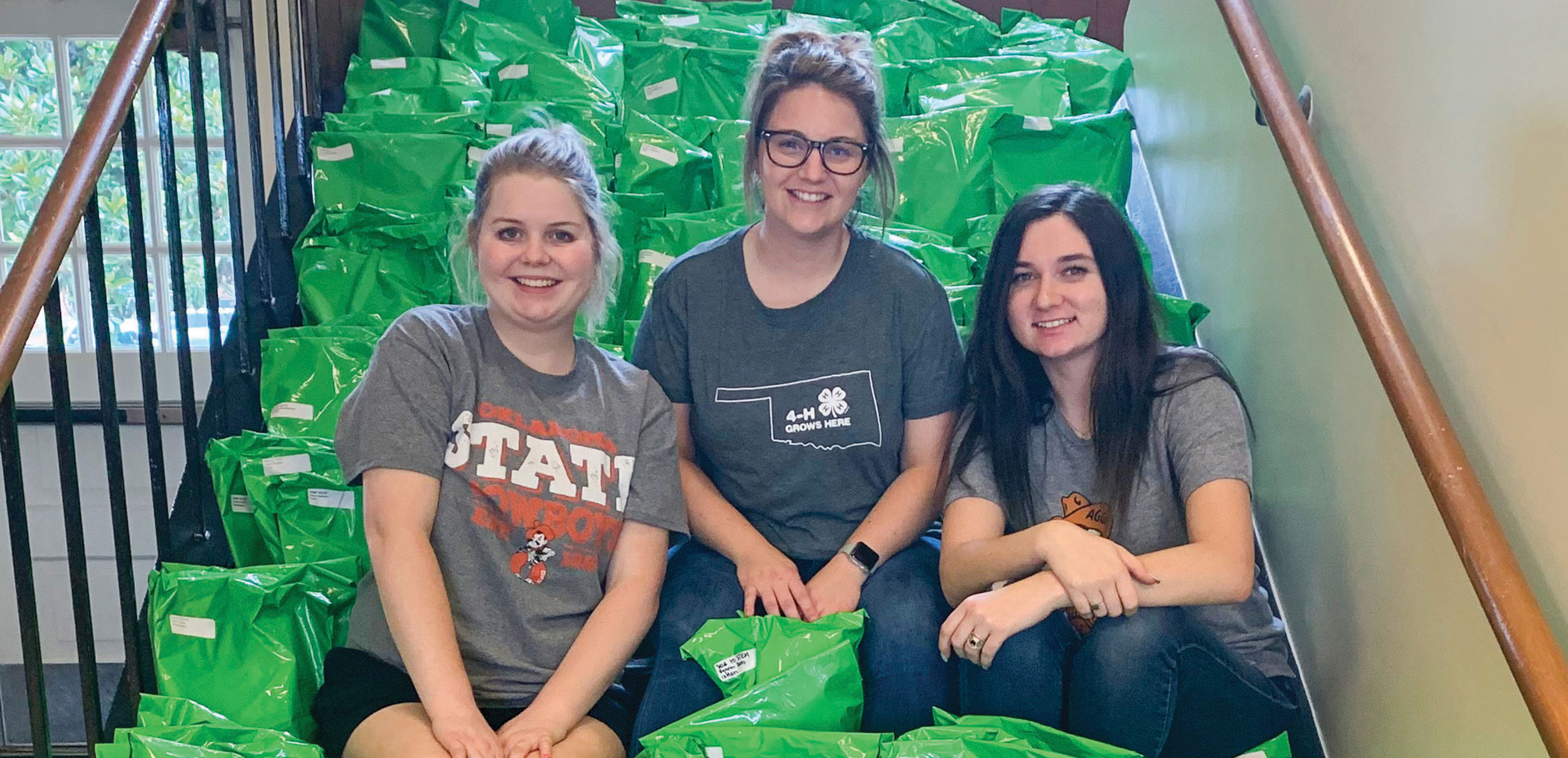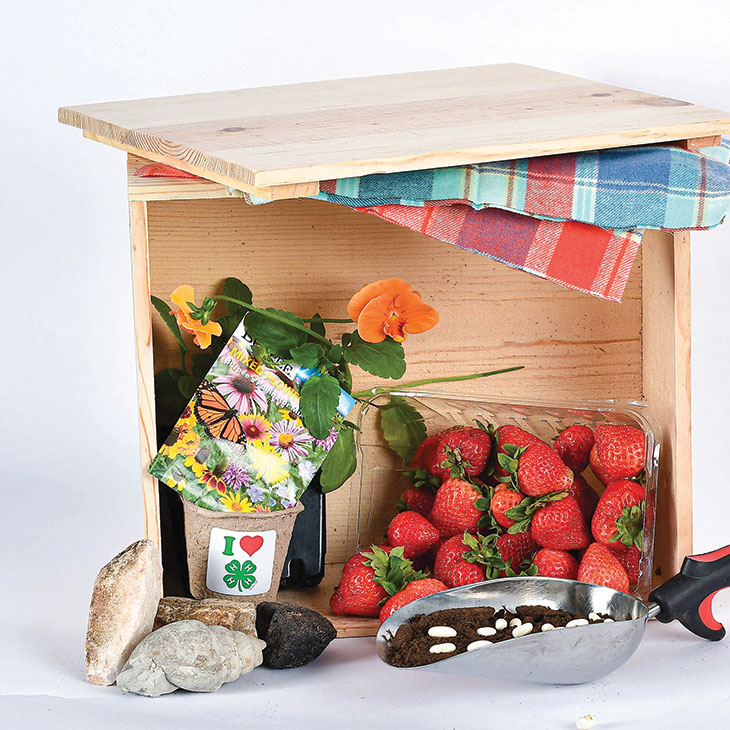
Roots & Rocks
Friday, December 17, 2021
Media Contact: Samantha Siler | Communications and Marketing Manager | 405-744-2977 | samantha.siler@okstate.edu
Strawberry DNA, geodes and plants galore — what do those things have in common?
The 4-H STEM Camp in a Box program included these items and more during the summer of 2021.
Oklahoma 4-H Youth Development and the Oklahoma Established Program to Stimulate Competitive Research, or EPSCoR, partnered to offer virtual science, technology, engineering and math programming for the state’s 4-H members.
The Camp in a Box program was first developed by Alex Cox when she was a 4-H educator in McClain County, Oklahoma. Cox wanted a way to engage with her 4-H students during the pandemic, she said.
The program blossomed when Cox moved into her role as the EPSCoR STEM specialist, she said. The 2021 4-H STEM Camp in a Box program came to fruition because of the funding of the 4-H Youth Development and Beyond EPSCoR grant, she said.
This five-year grant outlined three educational areas for Cox to cover: carbon in the environment, water conservation in a sustainable world, and using new and renewable energy sources to power society.
The 2021 Oklahoma 4-H interns, called STEMists, received these parameters and were tasked with creating virtual programs for Oklahoma 4-H youth to participate in during this time of uncertainty, Cox said.
Caitlin Dreher, Oklahoma 4-H STEMist and agricultural leadership graduate student, chose to create her Camp in a Box program about plant and soil science, she said. Her program, Seed to STEM, taught students about DNA, plant biology, propagation and more, she said.
Kaylee Piatt, Oklahoma 4-H STEMist and agricultural communications senior, focused on geology, an often neglected area in the 4-H organization, Cox said.
Piatt’s program, named Camp Rock, engaged students with lessons about the Earth and geological formations, Piatt said.
This virtual camp experience provided a challenge for the STEMists — creating engaging, educational programming for students from ages 8 to 18, Dreher said.
“That is a wide range of students, and I hadn’t had experience teaching to all ages before,” Dreher said. “That was something I really had to consider when I was creating the curriculum.”
Piatt said she worried her geology programming might be too complex for younger students and would be boring to the older students.
Once the STEMists’ curriculum was written and students began enrolling in their desired programs, STEMists purchased the materials their students would receive.
Before the online camps began, the supplies for each camp were shipped for individual participants to pick up at their respective Oklahoma State University Extension county offices.
Students who did not pre-register were still invited to participate, but they were required to supply their own materials, Cox said.
Piatt purchased supplies to help her students learn about the Earth’s layers, geodes and fossils, she said.
The STEM kits her students received included Play-Doh, Jolly Ranchers, gummy candies and straws.

“In one lesson, they got to crush up Jolly Ranchers, put them in the silicone mold and bake them,” Piatt said. “After they were baked, the participants dusted them with cocoa powder to make them look like geodes.”
Camp Rock students also could participate in an activity that illustrated the layers of Earth.
By stacking layers of Play-Doh and using a straw to gather a sample from each layer, students could understand what is happening below their feet, Cox said.
Although each kit was focused toward hands-on experiences, each program used different materials to further student learning.
Dreher’s STEM kits included a bag of soil, seeds, marshmallows, Twizzlers, and more to help members learn about plant and soil sciences.
Dreher’s students extracted DNA from strawberries, propagated seeds, and learned about how plants grow, she said. Each lesson focused on a different aspect of plant and soil science.
“It was overwhelming the number of kids that we had sign up,” Dreher said. “It was definitely exciting, but unexpected. It was exciting to reach that many kids, but it created a lot of work to get supplies out to everybody.”
When the camps began in July, new videos were released every week on the Oklahoma 4-H website, and students could follow along at home, Cox said.
Seed to STEM videos appeared every Monday and Camp Rock videos were posted on Fridays.
The decision to use pre-recorded videos allowed the students to complete each project on their own time, Cox said. This helped avoid conflicts that arise with live demonstrations on Zoom, she said.
“Videos were released weekly to allow the kids a week’s time to get that project done and provide us with pictures, quotes and feedback,” Cox said.
Students enjoyed the core sampling activity from Camp Rock and the strawberry DNA extraction activity from Seed to STEM most, Cox said.
Students and their parents sent in photos and notes to the STEMists detailing how much they enjoyed these activities and the camps as a whole, Cox added.
All 77 counties in Oklahoma have a 4-H program.
“I believe we hit 67 Oklahoma counties,” Cox said. “We had a huge reach and impact, and sometimes we don’t see that when we conduct typical face-to-face programming.”
Cox and the STEMists created informational programming that allowed students to get hands-on learning from their homes, Cox said. She expects the program to continue, she said.
“There is room for improvements and expanding to other areas of STEM programming,” Cox said.
A total of 363 Oklahoma 4-H members learned about STEM programming thanks to Oklahoma 4-H and EPSCoR in 2021.
“My favorite part was all the pictures their parents would send me and seeing the smiles on their faces,” Piatt said. “I was worried my lessons wouldn’t be fun, or the projects would be boring.
“But at the end of the day, getting those reviews from the parents and seeing those pictures made all those hours easier and made it worth it,” Piatt said.
Story By: Lindsey Jones | Cowboy Journal
